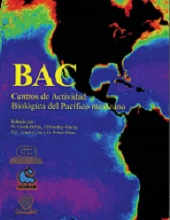| dc.creator | DANIEL LLUCH BELDA | |
| dc.creator | JUAN FELIX ELORDUY GARAY | |
| dc.creator | SALVADOR EMILIO LLUCH COTA | |
| dc.creator | GERMAN PONCE DIAZ | |
| dc.date | 2000 | |
| dc.identifier | http://cibnor.repositorioinstitucional.mx/jspui/handle/1001/1437 | |
| dc.identifier.uri | http://dspace.cibnor.mx:8080/handle/123456789/2788 | |
| dc.description | "The studies compiled in this volume concern a concept that arose out of international discussions in La Paz, B.C.S., Mexico, concerning variations in the abundance and distribution of small pelagic fishes and their possible relation to changes in the physical environment. Of particular interest were species of sardine and anchovy that are common to eastern boundary currents, such as those of California and Mexico, Peru, and southwest Africa, where they are nourished by the high productivity associated with the upwelling of plant nutrients.
Even in these generally productive regions, there are smaller areas where biological activity is particularly high. These areas appear to be fixed in space, tied to coastal features, and tend to show little seasonal variation in their level of productivity. They are often the locus of spawning of small pelagics and other species and of fisheries related to the aggregations of commercial species. They have been dubbed "Biological Action Centers" or BAC.
Because of their characteristics, BAC are likely to be good places to study interactions between ecosystem and climate variations and to examine the mechanisms of such interactions. It has also been proposed that they offer an opportunity to optimize monitoring of ecosystem changes, analogous to checking blood pressure and pulse as indices of human health.
The possibility of improving the efficiency of living marine resource monitoring by concentrating observations in these small areas of high biological activity was attractive to the Living Marine Resource Panel of the Global Ocean Observing System, an international program being developed by the Intergovernmental Oceanographic Commission and other international agencies. That Panel proposed a pilot study to investigate BAC and their ecosystem role, to identify existing BAC, to determine the extent to which observations in BAC could be extrapolated to surrounding areas, and to investigate the extent to which BAC provide an indication of climate change.
Under the sponsorship of Instituto Interamericano para la Investigacion del Cambio Global (IAI), several workshops were organized to explore these ideas. The papers in the present volume resulted from the first Mexican workshop on the subject." | |
| dc.description | "Los estudios compilados en este volumen tocan un concepto que nació de las discusiones a nivel internacional realizadas en La Paz, B.C.S., México, concernientes a las variaciones en la abundancia y distribución de peces pelágicos menores y su posible relación con los cambios en el ambiente físico. Fueron de interés particular las especies de sardina y anchoveta comunes a las corrientes con frontera al este, tales como las de California y México, Perú y Suroeste de África, donde son alimentadas por la gran productividad asociada con las surgencias de nutrientes de plantas.
Incluso en estas regiones generalmente productivas, existen áreas menores donde la actividad biológica es particularmente elevada. Estas áreas parecen estar fijas en el espacio, ligadas a características de la costa, y tienden a mostrar poca variación estacional en su nivel de productividad. A menudo son el lugar de desove de pelágicos menores y otras especies y de pesquerías relacionadas con las agregaciones de especies comerciales. Han sido denominadas "Centros de Actividad Biológica" o BAC (por sus siglas en inglés).
Debido a sus características, es probable que los BAC sean buenos lugares para el estudio de las interacciones entre el ecosistema y las variaciones climáticas y para examinar los mecanismos de tales interacciones. También se ha propuesto que ofrecen la oportunidad de optimizar el monitoreo de los cambios del ecosistema, de forma análoga a como se verifican la presión sanguínea y el pulso en cuanto a la salud humana.
La posibilidad de mejorar la eficiencia del monitoreo de recursos marinos vivos concentrando las observaciones en estas pequeñas áreas de elevada actividad biológica fue atractiva para el Panel de Recursos Marinos Vivos del Sistema de Observación Global de los Océanos (LMR-GOOS), un programa internacional que está siendo desarrollado por la Comisión Oceanográfica Intergubernamental (IOC) y otras agencias internacionales. Dicho Panel propuso un estudio piloto para investigar los BAC y el papel de sus ecosistemas, para identificar los BAC existentes, para determinar en qué grado las observaciones en los BAC podrían ser extrapoladas a las áreas circundantes, y para investigar en qué grado los BAC proporcionan una indicación del cambio climático." | |
| dc.format | application/pdf | |
| dc.language | spa | |
| dc.publisher | Centro de Investigaciones Biológicas del Noroeste, S. C. | |
| dc.publisher | Centro Interdisciplinario de Ciencias Marinas del Instituto Politécnico Nacional | |
| dc.publisher | Consejo Nacional de Ciencia y Tecnología | |
| dc.relation | info:eu-repo/semantics/reference/ISBN/ISBN: 970-18-6285-6 | |
| dc.rights | info:eu-repo/semantics/openAccess | |
| dc.rights | http://creativecommons.org/licenses/by-nc-nd/4.0 | |
| dc.source | BAC: centros de actividad biológica del Pacífico mexicano | |
| dc.subject | info:eu-repo/classification/AUTOR/ECOLOGÍA MARINA, OCEANOGRAFÍA BIOLÓGICA, PRODUCTIVIDAD MARINA | |
| dc.subject | info:eu-repo/classification/cti/1 | |
| dc.subject | info:eu-repo/classification/cti/25 | |
| dc.subject | info:eu-repo/classification/cti/2510 | |
| dc.subject | info:eu-repo/classification/cti/251001 | |
| dc.subject | info:eu-repo/classification/cti/251001 | |
| dc.title | BAC: Centros de Actividad Biológica del Pacífico mexicano | |
| dc.type | info:eu-repo/semantics/book | |
| dc.type | info:eu-repo/semantics/publishedVersion | |


